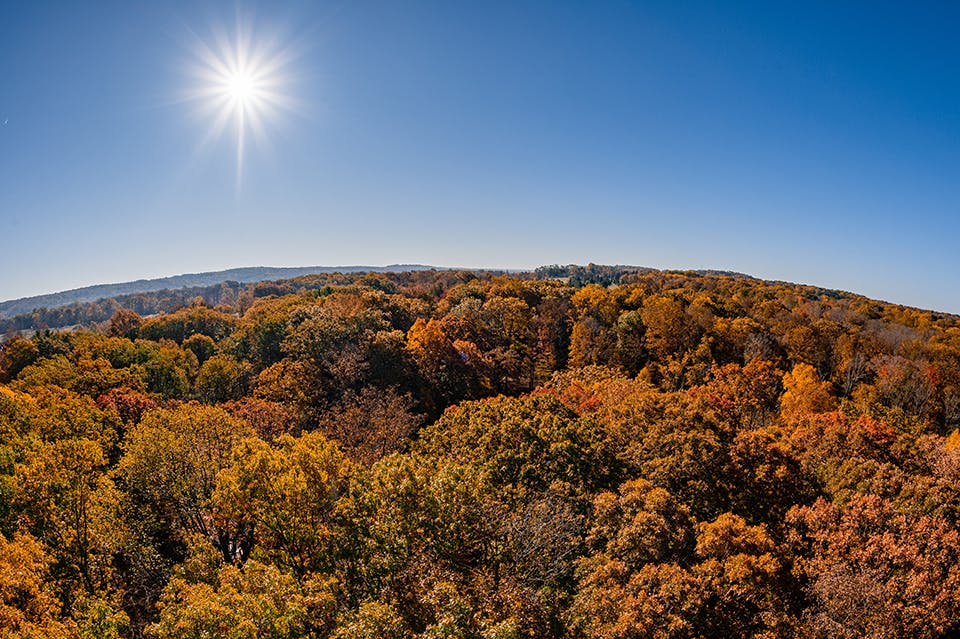Ohio Arboretums and Botanical Gardens to Visit this Fall
Autumn is a perfect time to explore the variety of arboretums and botanical gardens across our state.
Sept./Oct. 2022
BY Macy Kile, Sarah Miller, Emma Shinker, Rebecca Vernak and Krista Willis | Photo by Erik Drost
Sept./Oct. 2022
BY Macy Kile, Sarah Miller, Emma Shinker, Rebecca Vernak and Krista Willis | Photo by Erik Drost
Holden Arboretum, Kirtland
Every autumn, Holden Arboretum bursts into a fairytale-like landscape of trails that wind through warm-colored woods and charming gardens. The fragrance of fall is strong as leaves drop from the trees to join the ones freshly scattered on the ground.
The pathways throughout these 3,500 acres in Kirtland feature signs noting which of the arboretum’s more than 21,000 different plant and tree species are located nearby. Some of the most beautiful trees this time of year include the golden-yellow sweet birch, the red-orange sugar maple and the blue-green Himalayan pine.
Along the way, visitors pass by a Zen garden, flowing brook and still pond topped with a scattering of lily pads, as well as a play area for children — Buckeye Bud’s Adventure Woods — built so it serves as a complement to the nature surrounding it.
Check out Patrick Dougherty’s “Stickwork,” nature-inspired sculptures weaved from pliable willow sticks and branches that capture both your attention and your imagination. (The Holden Arboretum installation is the renowned artist’s first in northeast Ohio.)
To take in the season’s fall colors from above, ascend the 120-foot Kalberer Emergent Tower, complete with a sitting area so those climbing it can rest about halfway up. From the top, visitors can take in a wide expanse of red, orange, brown and golden leaves and a glimpse of Lake Erie on the distant horizon. The Murch Canopy Walk — a 500-foot-long walkway 65 feet above the forest floor — offers the chance to check out colorful fall leaves at eye level. A tram tour is also available so visitors can cover more ground, while enjoying the foliage and learning about the history of the arboretum, which was founded in 1931.
9550 Sperry Rd., Kirtland 44094, 440/946-4400, holdenfg.org
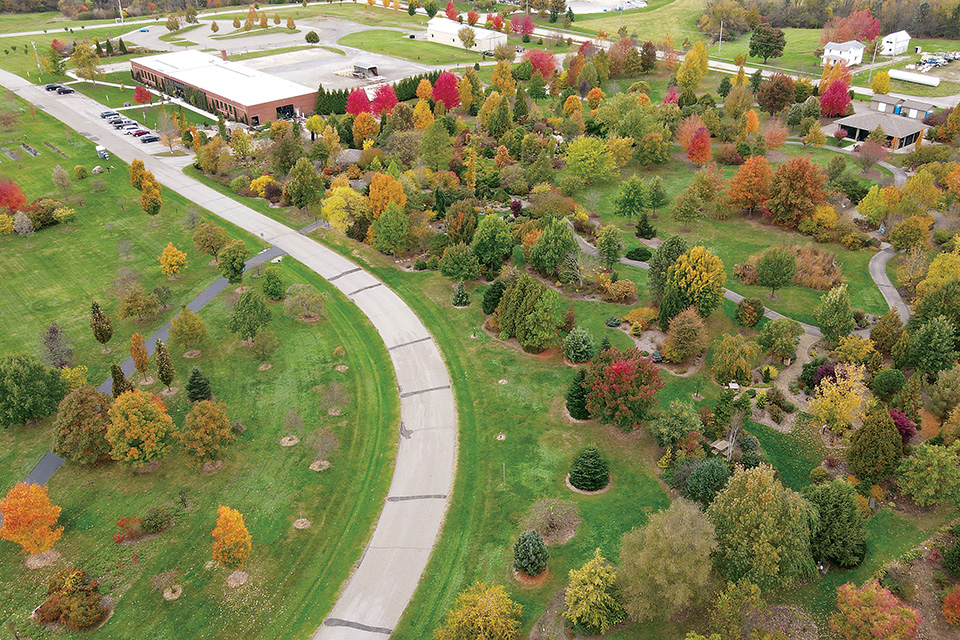
Secrest Arboretum, Wooster
Part of The Ohio State University’s College of Food, Agricultural and Environmental Sciences at its Wooster campus, Secrest Arboretum collects horticulturally relevant trees, shrubs and herbaceous plant species. First planted in 1904, the arboretum aims to connect people with plants and to serve as a living resource for ornamental horticulture education and research. It is an inviting place to explore and is open to the public year-round.
The 110-acre botanical garden contains 4,000 plant varieties from around the globe, with the various themed gardens offering paved pathways and seating areas that make it a great place for a walk. The work being done here is a merger of art, science and business that is of particular benefit to the nursery and landscaping industries, which are both significant in Ohio.
“Art through the color, texture and design that we implement,” explains Jason Veil, curator for the Secret Arboretum. “Science through the research we conduct.”
Throughout the year, visitors can enjoy guided walks, self-guided tours, plant sales and community events. One of the most popular times to visit is during autumn, which offers the opportunity to take in plenty of fall foliage.
“Any given day in late October is when you can see beautiful fall colors,” Veil says. “There is never not a day that you can find something really interesting.”
2122 Williams Rd., Wooster 44691, 330/263-3761, secrest.osu.edu
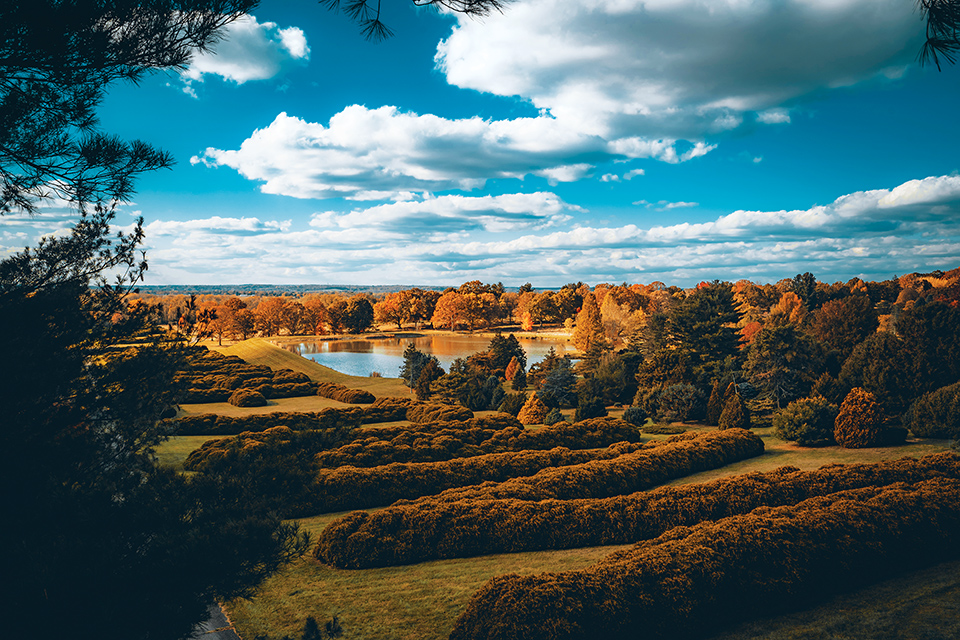
The Dawes Arboretum, Newark
From the top of the three-level observation tower, you can see Conifer Glen, the sky reflecting off Dawes Lake and the famous hedge that spells out the arboretum’s name. With nearly 2,000 acres of land, 11 miles of walking trails, 4 miles of auto trails and a variety of gardens and woodland areas to explore, The Dawes Arboretum in Newark is a year-round destination. During the fall though, it is painted with splashes of soft yellows, vibrant oranges and deep scarlets that make it a beautiful time to visit.
The arboretum, which was founded in 1929, catalogs and preserves a collection of 17,000 different plants from around the globe and offers visitors a place of both tranquility and education. There’s the Azalea Glen, Oak Hill, collections of maples, magnolias and much more. Find peace at the Japanese Garden that landscape architect Makoto Nakamura designed in 1963. It consists of a small pond surrounded by cherry trees that provides a place for quiet reflection. Holly Hill offers a variety of holly species arranged to show off the yellow, dark purple and red berries that arrive during fall and winter. Stop by after a light dusting of snow to view this gorgeous landscape.
During your visit, also be sure to schedule a tour of the Daweswood House Museum & History Center, where the house, furniture and clothing of the arboretum’s founders, Beman and Bertie Dawes, have been preserved. Stop by the visitors center to pick up a map of the grounds, browse the gift shop and buy your own plant.
7770 Jackson Rd., Newark 43056, 740/323-2355, dawesarb.org
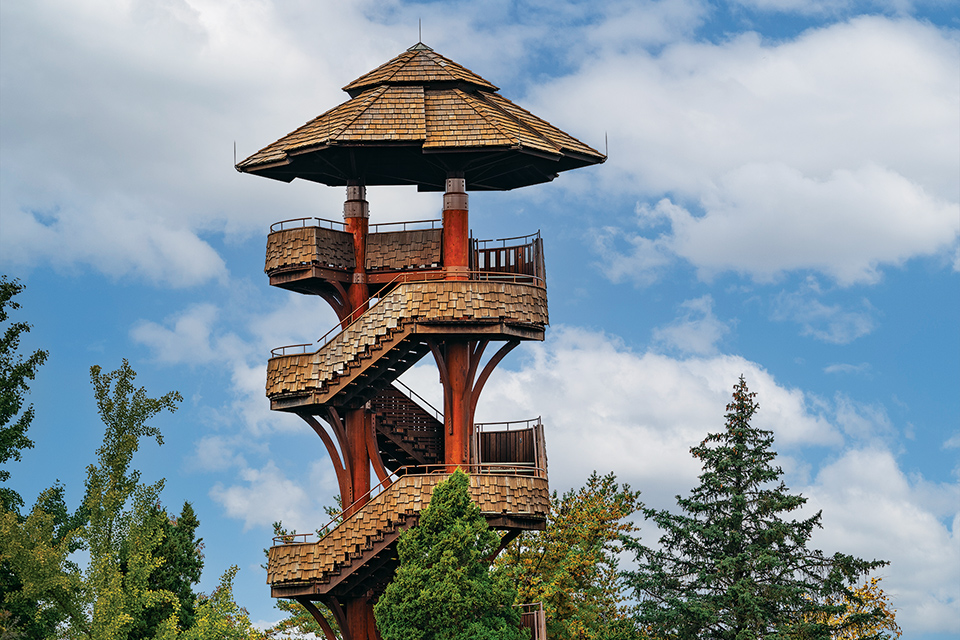
Cox Arboretum, Dayton
Blazing autumn colors are often best seen from above, and Cox Arboretum MetroPark offers the perfect perch 56 feet above its conifer collection. Aerial views of majestic pines mix with warm golds and fiery reds that stretch across the Miami Valley. The Tree Tower’s 81-step climb rewards visitors with a shaded terrace to take in the view. Made from Douglas fir, the tower is a focal point of the park and provides a stunning perspective.
Ground-level viewing of fall foliage is abundant across the arboretum’s 174 acres as well. What was once barren farmland has become one of Dayton’s natural jewels. Over 50 years ago, The Cox Arboretum Foundation and community members transformed the land, and it operates today under a public-private partnership with Dayton’s Five Rivers MetroParks.
Colorful canopies overhead provide cover for leisurely strolls on winding trails, and Cox Arboretum horticulturist Kelly Woods suggests taking the yellow and blue nature trails through the woodlands.
“Also, I like the southwest corner near Bauer School,” she adds. “There are multiple sweet gum trees on the path around the perimeter of that back pond with maple trees that create a rainbow of colors as they start dropping their leaves.”
Mid-October through mid-November is generally a great time to visit. Black tupelo, sassafras, and Ohio’s native pawpaw tree are just a handful of species changing alongside purple aster, goldenrod and fall berries. Watch for goldfinches plucking thistle seeds or head to the bird blind for more birdwatching on the pond.
Whether visitors want to climb the Tree Tower or meander over the Monet Bridge to check out fall reflections on the water, Cox Arboretum offers a wealth of opportunities to unwind and soak in autumn’s beauty.
6733 N. Springboro Pike, Dayton 45449, 937/275-7275, metroparks.org
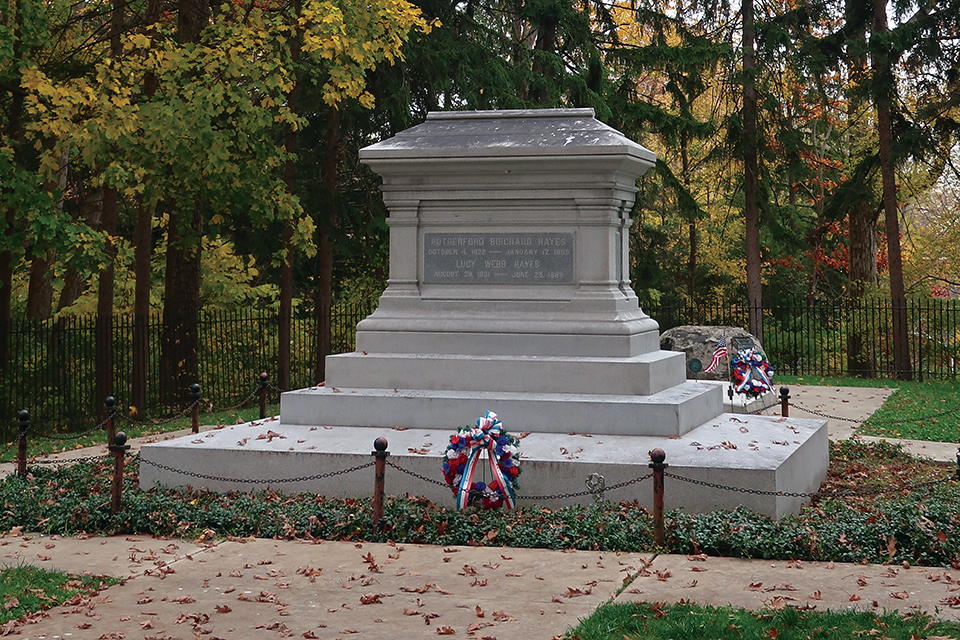
Spiegel Grove, Fremont
During autumn, the 25 acres that surround the Rutherford B. Hayes Presidential Library & Museums in Fremont deliver a colorful show. Golden-leaved ginkgoes and scarlet red maples complement Fremont’s stately Hayes home, and in 2021, Spiegel Grove received the added distinction of becoming an accredited arboretum.
“With 95 different tree species, something’s always happening,” says John Havens, superintendent of buildings and grounds.
Havens adds that the collection contains both rare and native species. Massive white oaks — one standing since 1776 — measuring 21 feet around are among the trees growing on the property. President Hayes and his second son, Web Hayes, planted various tree species on the grounds and kept detailed writings. The arboretum has an offspring from George Washington’s original Tulip Poplar tree. Other trees across the grounds are named for those who visited the Hayes home over the years.
One afternoon, President William Howard Taft was sitting on the home’s veranda when Web Hayes explained to him that he could choose a tree to be named for him. The story goes that the famously stout Taft went out to an ample-sized oak tree, touched it and said, “This one has enough girth to be named after me,” recounts Havens.
Natural beauty and American history are constant companions at Spiegel Grove. Over a mile of walking paths zig zag across the estate designed as Web Hayes envisioned in the early 20th century.
Spiegel Grove, Fremont 43420, 419/332-2081, rbhayes.org
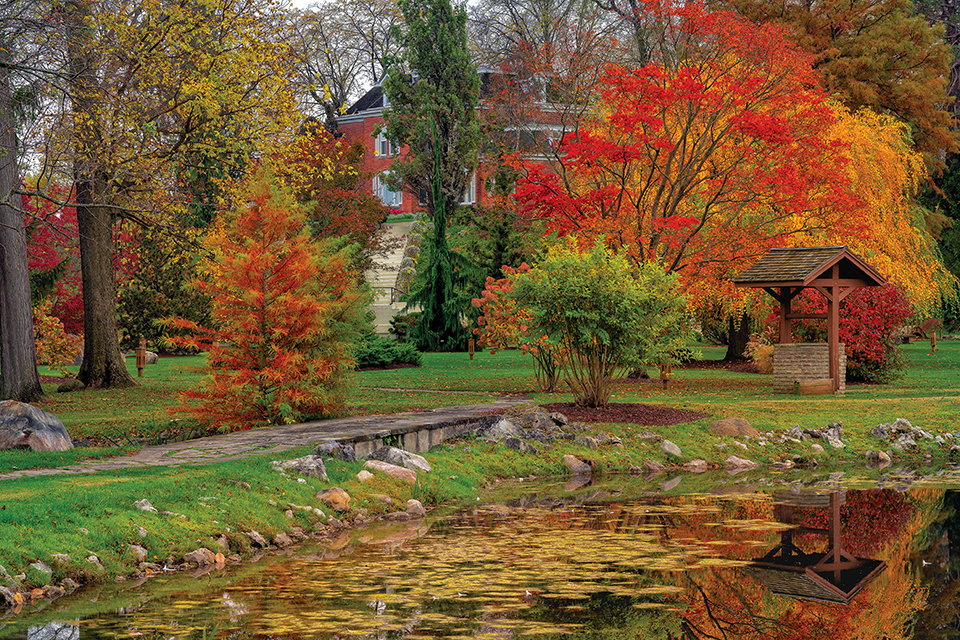
MORE ARBORETUMS
Zoar Wetland Arboretum, Zoar: Situated between the historic Zoar Village and the Ohio & Erie Canal Towpath Trail, this arboretum contains 30 acres of wetlands and 50 acres of woodlands. zoarwetland.org
Chadwick Arboretum, Columbus: Located on The Ohio State University’s main campus, Chadwick Arboretum and Learning Gardens consists of over 60 acres of green space distributed throughout an urban setting. chadwickarboretum.osu.edu
Stanley Rowe Arboretum, Indian Hill: Spanning almost 10 acres in the village of Indian Hill, located just outside the city of Cincinnati, this spot specializes in conifers and offers casual walking trails. indianhill.gov/recreation/rowe-arboretum
James. A. McBride Arboretum, Huron: This arboretum has over 200 species of plants spread out across restored prairies, landscaped gardens and wooded areas at Bowling Green State University’s Firelands Campus. firelands.bgsu.edu
Schedel Arboretum & Gardens, Elmore: Explore themed gardens and browse an extensive collection of lithophanes at this 17-acre botanical garden and arboretum located just southeast of Toledo. schedel-gardens.org
Mt. Airy Arboretum, Cincinnati: Located within Mt. Airy Forest, this arboretum’s 30 acres are filled with trees, shrubs, flowers and a lake to admire from one of the many walkways. cincinnati-oh.gov/cincyparks
Spring Grove Cemetery & Arboretum, Cincinnati: Founded in 1845, this designated National Historic Landmark covers 750 acres and is one of the largest cemeteries in the United States. springgrove.org
Bull’s Run Nature Sanctuary and Arboretum, Middletown: Bull’s Run Nature Sanctuary and Arboretum educates the community while protecting a variety of wildlife and the last free-flowing section of Bull’s Run Creek. bullsrun.org
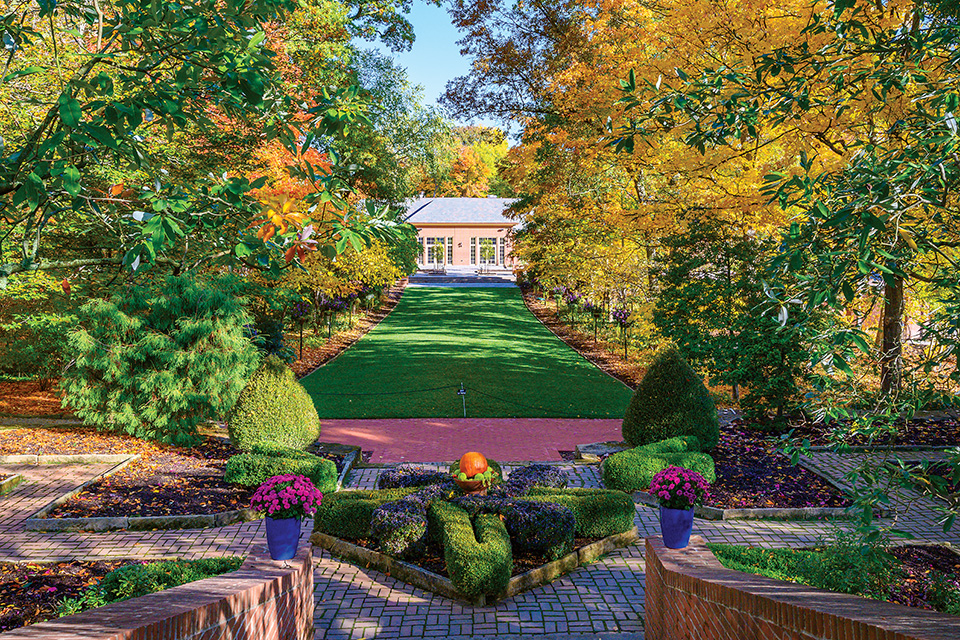
Botanical Gardens
Kingwood Center Gardens, Mansfield
Driving into the former estate of Charles Kelley King, bright yellow leaves fan out from the ginkgo biloba trees. Pass through the Garden Gateway for immersive fall displays that include cabbage, kale and mums. The 15-foot mum tree — a steel structure with 250-plus individual plants in an A-frame — blooming from solid green to yellows, reds and oranges is a highlight. The Great Pumpkin Glow, which features 1,000 carved pumpkins, enchants visitors Oct. 21 through 23. kingwoodcenter.org
Franklin Park Conservatory and Botanical Gardens, Columbus
During Harvest Blooms, running Sept. 24 through Oct. 31, thousands of heirloom gourds and pumpkins splash the landscape. Mix in hundreds of mums, brassicas, pansies and fall plants for an explosion of vibrant color. Crunch through the leaves of the old-growth trees in the Grand Mallway, and see fruit such as buckeyes, pawpaw and sumac grow in the children’s garden. During select nights in October, Pumpkins Aglow transforms the conservatory into an illuminated spectacle. fpconservatory.org
Cleveland Botanical Garden, Cleveland
Take in the colors of fall at this University Circle neighborhood favorite. Wind through the Woodland Gardens featuring more than 30 tree species including beech, hemlock, maple and wild cherry as you cross bridges over small streams and pass a treehouse. Throughout the gardens, fall blooms mix with autumn displays such as hay bales, pumpkins and corn stalks, and the C.K. Patrick Perennial Border pops with dazzling purples from the beautyberry, monkshood and aster blooms. holdenfg.org
Toledo Botanical Gardens, Toledo
Spy the maidenhair trees’ stunning yellow at the south entrance, then walk to the Grand Allee, where silver lindens turn to gold across Crosby Lake. From the lake’s north side, check out the rusty hues of the bald cypress. Kids can visit the newly created Secret Forest play area with bright orange sugar maples nearby. Rich reds of the sweet gum tree contrast with rainbows of yellows, reds, orange and even the white ash’s purple. metroparkstoledo.com
Related Articles

When Will Fall Color Peak in Ohio?
Peak autumn color is here across the state. It’s time to get out there and see it. READ MORE >>

50 Things to Do This Fall in Ohio
Autumn is our most beautiful season. From family fun and food festivals to scenic spots and spooky scares, here are great ways to embrace the crisp air and sunny days. READ MORE >>
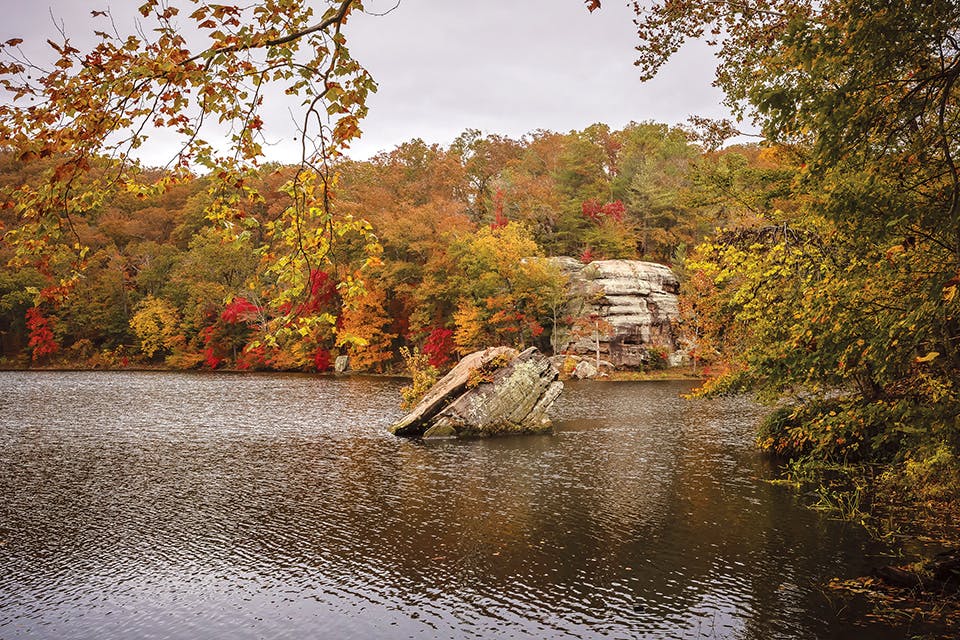
10 Scenic Spots in Ohio to Visit this Fall
Explore vibrant foliage at Wayne National Forest's Lake Vesuvius, tour Ashtabula County's covered bridges and hop aboard the Cuyahoga Valley Scenic Railroad. READ MORE >>


